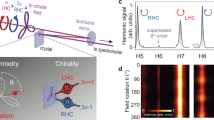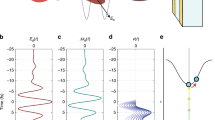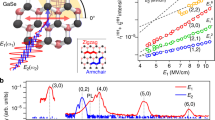Abstract
Electric-field-induced charge separation (polarization) is the most fundamental manifestation of the interaction of light with matter and a phenomenon of great technological relevance. Nonlinear optical polarization1,2 produces coherent radiation in spectral ranges inaccessible by lasers and constitutes the key to ultimate-speed signal manipulation. Terahertz techniques3,4,5,6,7,8 have provided experimental access to this important observable up to frequencies of several terahertz9,10,11,12,13. Here we demonstrate that attosecond metrology14 extends the resolution to petahertz frequencies of visible light. Attosecond polarization spectroscopy allows measurement of the response of the electronic system of silica to strong (more than one volt per ångström) few-cycle optical (about 750 nanometres) fields. Our proof-of-concept study provides time-resolved insight into the attosecond nonlinear polarization and the light–matter energy transfer dynamics behind the optical Kerr effect and multi-photon absorption. Timing the nonlinear polarization relative to the driving laser electric field with sub-30-attosecond accuracy yields direct quantitative access to both the reversible and irreversible energy exchange between visible–infrared light and electrons. Quantitative determination of dissipation within a signal manipulation cycle of only a few femtoseconds duration (by measurement and ab initio calculation) reveals the feasibility of dielectric optical switching at clock rates above 100 terahertz. The observed sub-femtosecond rise of energy transfer from the field to the material (for a peak electric field strength exceeding 2.5 volts per ångström) in turn indicates the viability of petahertz-bandwidth metrology with a solid-state device.
This is a preview of subscription content, access via your institution
Access options
Subscribe to this journal
Receive 51 print issues and online access
$199.00 per year
only $3.90 per issue
Buy this article
- Purchase on Springer Link
- Instant access to full article PDF
Prices may be subject to local taxes which are calculated during checkout




Similar content being viewed by others
References
Boyd, R. W. Nonlinear Optics (Academic Press, Elsevier, 2008)
Wegener, M. Extreme Nonlinear Optics: an Introduction (Springer, 2005)
Valdmanis, J. A., Mourou, G. & Gabel, C. W. Picosecond electro-optic sampling system. Appl. Phys. Lett. 41, 211–212 (1982)
Wu, Q. & Zhang, X. C. Free-space electro-optic sampling of terahertz beams. Appl. Phys. Lett. 67, 3523 (1995)
Sell, A., Leitenstorfer, A. & Huber, R. Phase-locked generation and field-resolved detection of widely tunable terahertz pulses with amplitudes exceeding 100 MV/cm. Opt. Lett. 33, 2767–2769 (2008)
Hebling, J., Lo Yeh, K., Hoffmann, M. C. & Nelson, K. A. High-power THz generation, THz nonlinear optics, and THz nonlinear spectroscopy. IEEE J. Sel. Top. Quantum Electron. 14, 345–353 (2008)
Huber, R. et al. Switching ultrastrong light–matter coupling on a subcycle scale. J. Appl. Phys. 109, 102418 (2011)
Leitenstorfer, A., Nelson, K. A., Reimann, K. & Tanaka, K. Focus on nonlinear terahertz studies. New J. Phys. 16, 045016 (2014)
Kuehn, W. et al. Terahertz-induced interband tunneling of electrons in GaAs. Phys. Rev. B 82, 075204 (2010)
Junginger, F. et al. Nonperturbative interband response of a bulk InSb semiconductor driven off resonantly by terahertz electromagnetic few-cycle pulses. Phys. Rev. Lett. 109, 147403 (2012)
Somma, C., Reimann, K., Flytzanis, C., Elsaesser, T. & Woerner, M. High-field terahertz bulk photovoltaic effect in lithium niobate. Phys. Rev. Lett. 112, 146602 (2014)
Ulbricht, R., Hendry, E., Shan, J., Heinz, T. F. & Bonn, M. Carrier dynamics in semiconductors studied with time-resolved terahertz spectroscopy. Rev. Mod. Phys. 83, 543–586 (2011)
Kampfrath, T., Tanaka, K. & Nelson, K. A. Resonant and nonresonant control over matter and light by intense terahertz transients. Nature Photon. 7, 680–690 (2013)
Krausz, F. & Ivanov, M. Attosecond physics. Rev. Mod. Phys. 81, 163–234 (2009)
Taur, Y. & Ning, T. H. Fundamentals of Modern VLSI Devices (Cambridge Univ. Press, 2009)
Markov, I. L. Limits on fundamental limits to computation. Nature 512, 147–154 (2014)
Ionescu, A. M. & Riel, H. Tunnel field-effect transistors as energy-efficient electronic switches. Nature 479, 329–337 (2011)
Schiffrin, A. et al. Optical-field-induced current in dielectrics. Nature 493, 70–74 (2012)
Schultze, M. et al. Controlling dielectrics with the electric field of light. Nature 493, 75–78 (2012)
Itatani, J. et al. Attosecond streak camera. Phys. Rev. Lett. 88, 173903 (2002)
Kienberger, R. et al. Atomic transient recorder. Nature 427, 817–821 (2004)
Pati, A. P., Wahyutama, I. S. & Pfeiffer, A. N. Subcycle-resolved probe retardation in strong-field pumped dielectrics. Nature Commun. 6, 7746 (2015)
Loriot, V., Hertz, E., Faucher, O. & Lavorel, B. Measurement of high order Kerr refractive index of major air components. Opt. Express 17, 13429–13434 (2009); erratum 18, 3011–3012 (2010)
Brée, C., Demircan, A. & Steinmeyer, G. Saturation of the all-optical Kerr effect. Phys. Rev. Lett. 106, 183902 (2011)
Geissler, M. et al. Light propagation in field-ionizing media: extreme nonlinear optics. Phys. Rev. Lett. 83, 2930–2933 (1999)
Yabana, K., Sugiyama, T., Shinohara, Y., Otobe, T. & Bertsch, G. Time-dependent density functional theory for strong electromagnetic fields in crystalline solids. Phys. Rev. B 85, 045134 (2012)
Yablonovitch, E., Heritage, J. P., Aspnes, D. E. & Yafet, Y. Virtual photoconductivity. Phys. Rev. Lett. 63, 976–979 (1989)
Cavaleri, A. L. et al. Intense 1.5-cycle near infrared laser waveforms and their use for the generation of ultra-broadband soft-x-ray harmonic continua. New J. Phys. 9, 242 (2007)
Milam, D. Review and assessment of measured values of the nonlinear refractive-index coefficient of fused silica. Appl. Opt. 37, 546–550 (1998)
Acknowledgements
We acknowledge discussions with M. Stockman and V. Apalkov. This work was supported by the Max Planck Society and the Deutsche Forschungsgemeinschaft Cluster of Excellence: Munich Centre for Advanced Photonics (http://www.munich-photonics.de). M.S. was supported by a Marie Curie International Outgoing Fellowship (FP7-PEOPLE-2011-IOF). E.M.B. acknowledges funding from the European Community’s Seventh Framework Programme (FP7/2007-2013) under grant agreement number 290605 (PSI-FELLOW/COFUND) and from the Swiss National Science Foundation through NCCR MUST. This research is based upon work supported by the US Air Force Office of Scientific Research under award number FA9550-16-1-0073 and used computational resources of the K computer provided by the RIKEN Advanced Institute for Computational Science through the HPCI System Research project (Project ID: hp140103).
Author information
Authors and Affiliations
Contributions
F.K. and M.S. initiated, conceived and supervised the study. A.S. and E.M.B. developed the experimental method. A.S., E.M.B. and C.J. (in close cooperation with T.L., O.R., M.J., W.S. and V.S.) prepared and performed the experiment. S.A.S., H.F., K.Y. and N.K. accomplished the theoretical modelling. A.S., E.M.B., V.S.Y., R.K., N.K., M.S. and F.K. analysed and interpreted the experimental data. All authors discussed the results and contributed to the final manuscript.
Corresponding authors
Ethics declarations
Competing interests
The authors declare no competing financial interests.
Supplementary information
Supplementary Information
This file contains Supplementary text and Data, Supplementary Figures 1-16 and Supplementary References. (PDF 2139 kb)
Rights and permissions
About this article
Cite this article
Sommer, A., Bothschafter, E., Sato, S. et al. Attosecond nonlinear polarization and light–matter energy transfer in solids. Nature 534, 86–90 (2016). https://doi.org/10.1038/nature17650
Received:
Accepted:
Published:
Issue Date:
DOI: https://doi.org/10.1038/nature17650
This article is cited by
-
Sub-cycle multidimensional spectroscopy of strongly correlated materials
Nature Photonics (2024)
-
Dynamic optical response of solids following 1-fs-scale photoinjection
Nature (2023)
-
Synthesis, Surface Morphology, Gas Sensor, DSC Technique and Third-Order Behavior of Conducting Polymer
Journal of Fluorescence (2023)
-
Size-controlled quantum dots reveal the impact of intraband transitions on high-order harmonic generation in solids
Nature Physics (2022)
-
Attosecond clocking of correlations between Bloch electrons
Nature (2022)
Comments
By submitting a comment you agree to abide by our Terms and Community Guidelines. If you find something abusive or that does not comply with our terms or guidelines please flag it as inappropriate.



